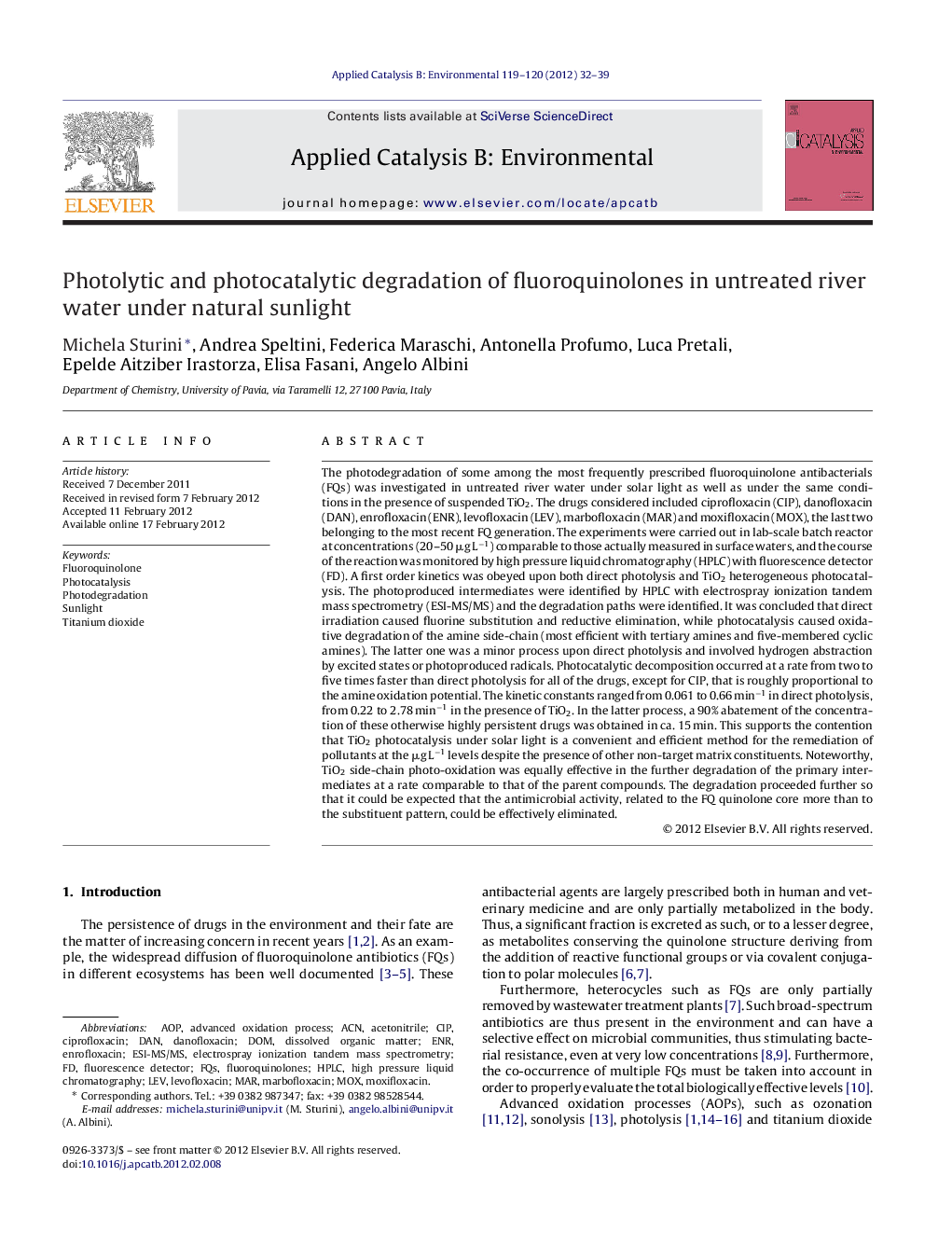| کد مقاله | کد نشریه | سال انتشار | مقاله انگلیسی | نسخه تمام متن |
|---|---|---|---|---|
| 46633 | 46444 | 2012 | 8 صفحه PDF | دانلود رایگان |

The photodegradation of some among the most frequently prescribed fluoroquinolone antibacterials (FQs) was investigated in untreated river water under solar light as well as under the same conditions in the presence of suspended TiO2. The drugs considered included ciprofloxacin (CIP), danofloxacin (DAN), enrofloxacin (ENR), levofloxacin (LEV), marbofloxacin (MAR) and moxifloxacin (MOX), the last two belonging to the most recent FQ generation. The experiments were carried out in lab-scale batch reactor at concentrations (20–50 μg L−1) comparable to those actually measured in surface waters, and the course of the reaction was monitored by high pressure liquid chromatography (HPLC) with fluorescence detector (FD). A first order kinetics was obeyed upon both direct photolysis and TiO2 heterogeneous photocatalysis. The photoproduced intermediates were identified by HPLC with electrospray ionization tandem mass spectrometry (ESI-MS/MS) and the degradation paths were identified. It was concluded that direct irradiation caused fluorine substitution and reductive elimination, while photocatalysis caused oxidative degradation of the amine side-chain (most efficient with tertiary amines and five-membered cyclic amines). The latter one was a minor process upon direct photolysis and involved hydrogen abstraction by excited states or photoproduced radicals. Photocatalytic decomposition occurred at a rate from two to five times faster than direct photolysis for all of the drugs, except for CIP, that is roughly proportional to the amine oxidation potential. The kinetic constants ranged from 0.061 to 0.66 min−1 in direct photolysis, from 0.22 to 2.78 min−1 in the presence of TiO2. In the latter process, a 90% abatement of the concentration of these otherwise highly persistent drugs was obtained in ca. 15 min. This supports the contention that TiO2 photocatalysis under solar light is a convenient and efficient method for the remediation of pollutants at the μg L−1 levels despite the presence of other non-target matrix constituents. Noteworthy, TiO2 side-chain photo-oxidation was equally effective in the further degradation of the primary intermediates at a rate comparable to that of the parent compounds. The degradation proceeded further so that it could be expected that the antimicrobial activity, related to the FQ quinolone core more than to the substituent pattern, could be effectively eliminated.
Figure optionsDownload as PowerPoint slideHighlights
► The photo(cata)lytic degradation of fluoroquinolones is studied in untreated river water.
► Realistic amounts (μg L−1) of drugs are quickly removed (15 min) from the matrix.
► Photocatalysis operates despite the presence of non-target matrix constituents.
► Fluoroquinolones byproducts are themselves photodegraded.
► TiO2 photocatalysis is a convenient procedure for fluoroquinolones remediation.
Journal: Applied Catalysis B: Environmental - Volumes 119–120, 30 May 2012, Pages 32–39